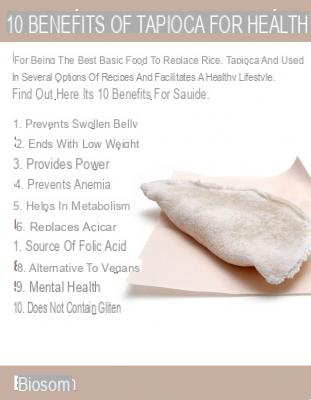
La flour of tapioca, also called cassava, cassava or yucca is extracted from the roots of the cassava plant and has a high calorific value with a reduced nutritional value.
Being naturally gluten-free, is useful in case of celiac disease or gluten sensitivity. Let's find out together!
How tapioca flour is made
Tapioca flour comes from the roots of cassava (Manihot esculenta), a plant native to South America, through a long and laborious process: dai grated tubers let the latex drain, to then be washed, squeezed, dehydrated, ground and sieved to obtain a powder, that is, the flour.
This has a sweet taste and is used in the kitchen especially as a thickener or for the preparation of desserts.
Properties and use of tapioca flour
Tapioca is primarily a starch, with a high calorific value and low nutritional value. With a sweetish taste and naturally gluten-free, it represents a good alternative in cooking and pastry for celiac or gluten-sensitive subjects.
It is easily found in well-stocked supermarkets and is used above all as a thickener and binder, similar to corn starch or rice flour, with which it can be replaced.
It can be used for the preparation of bread or cakes or to make puddings.
Furthermore, tapioca flour is commonly sold in the form of pearls of tapioca, obtained following a particular heat treatment, with which the famous bubble tea (Taiwanese drink) is prepared.
Tapioca flour is a source of resistant starch, that is, a fraction of starch that is not digested, acting as a fiber.
Resistant starch has been associated with several health benefits, including:
- It nourishes the good intestinal bacteria, to the detriment of harmful bacteria.
- Reduces inflammation.
- Improves glucose metabolism.
Tapioca among gluten-free cereals: discover the others
Where to buy cassava flour
For those who suffer from celiac disease or are sensitive to gluten it is not always so easy to find gluten free products on the market or prepare at home. Here is a practical, quick, healthy and tasty idea: tapioca crepes.
Cassava crepes, the recipe
Ingredients
- 500 g of cassava flour;
- 250 ml of water;
- Salt to taste
Preparation
- Mix the ingredients until you get a homogeneous mixture.
- Heat a non-stick pan and pour in about a ladle of mixture.
- Cook for about 2 minutes on each side, leaving the crepe white and not too golden.
- Stuff to taste and serve.
Read also
-
Tapioca, the multi-energy flour
-
3 recipes with tapioca flour
Bibliography and sources
A Comparative Evaluation of the Macronutrient and Micronutrient Profiles of Soybean-Fortified Gari and Tapioca, Food and Nutrition Bulletin
Utilization of resistant starch of native tapioca, corn and waxy corn starches and their retrograded preparations by Bifidobacterium, International Journal of Food Sciences and Nutrition
Resistant starch: the effect on postprandial glycemia, hormonal response, and satiety, The American Journal of Clinical Nutrition
The toxic effects of cassava (manihot esculenta grantz) diets on humans: a review, Veterinary and human toxicology


























